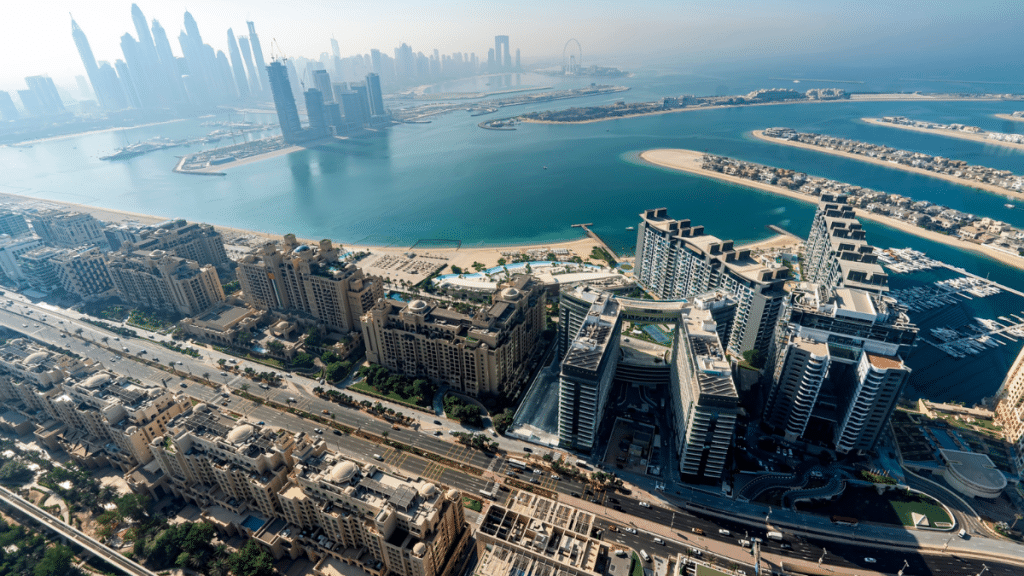When people think of Dubai’s iconic urban landscape, a few familiar names come to mind: Downtown, Dubai Marina, Palm Jumeirah. But a new coastal district is quietly establishing itself — and it’s not looking to replicate what’s already been done.
Dubai Maritime City (DMC), a once-industrial peninsula tucked between Port Rashid and Dubai Creek, is emerging as one of the city’s most intriguing transformation stories. Located just minutes from the heart of the city, DMC is rapidly evolving from a shipyard and logistics zone into a waterfront community with high-end residential projects, cultural venues, and hospitality experiences.
And yet, unlike many of Dubai’s high-profile real estate launches, DMC’s rise has been gradual, steady — almost discreet.
From Logistics Hub to Lifestyle Destination
Originally conceived in the early 2000s as a dedicated maritime industrial cluster, Dubai Maritime City was part of a larger vision to support the UAE’s shipping and marine services sector. For years, the peninsula remained relatively quiet in the public imagination — home to dry docks, warehouses, and maritime offices.
That image is now changing.
In line with the Dubai 2040 Urban Master Plan and broader efforts to rebalance the city’s development away from oversaturation in a few key districts, Dubai Maritime City is being repositioned as a coastal residential and mixed-use zone. New road links, upgraded infrastructure, and a defined urban framework are bringing clarity — and investment — to the area.
Today, the southern portion of the peninsula is being remade into a master-planned urban neighborhood. With zoning for mid-rise developments, walkable waterfronts, marinas, and hospitality venues, DMC is taking shape as a lifestyle destination with its own distinct character.
What Makes DMC Different?
Unlike newer artificial islands or reclaimed land projects, Dubai Maritime City has the advantage of being organically integrated into the city’s historical and geographic context. Surrounded by water on three sides, the peninsula enjoys uninterrupted sea views while offering fast access to Downtown, DIFC, Deira, and Jumeirah.
What makes the district especially attractive for development is its blend of urban centrality and spatial openness. DMC is close to the action — but not in the middle of the noise. It has the potential to deliver what many mature urban residents now seek: coastal proximity, architectural quality, and a sense of privacy.
Moreover, because the district is being developed from a largely clean slate, it allows architects and planners to experiment with scale, texture, and public realm design without the limitations of surrounding visual clutter. That freedom is beginning to attract projects that prioritize visual identity as much as real estate fundamentals.
The Rise of Design-Led Development
Among the early residential entries in the new Dubai Maritime City is The Mural by Beyond, a mid-rise project that takes cues from mural art in its façade treatment, spatial composition, and landscape integration.
This is not a tower trying to stand out through sheer height. Instead, the building is sculptural and expressive — a sign that DMC may become home to a different kind of architecture than what dominates much of Dubai.
Interestingly, The Mural by Omniyat, as it’s often referenced due to the developer’s brand heritage, is already gaining recognition for aligning with global trends in boutique residential design: limited units, functional elegance, strong orientation toward natural light, and curated amenity spaces.
But what makes this example particularly relevant is its location. The presence of a design-focused project like this in The Mural Maritime City context underscores how the district is being positioned not just for scale, but for style — not just for growth, but for quality.
What It Signals for the Broader Market
The quiet transformation of Dubai Maritime City reflects a larger trend across global cities: the reinvention of formerly industrial or portside zones into mixed-use urban destinations.
From Brooklyn’s waterfront to London’s Docklands to Hamburg’s HafenCity, cities are reclaiming their edges — and turning them into livable, culture-rich extensions of the urban core. In Dubai, where the waterfront has traditionally meant luxury towers and beach resorts, DMC offers a slightly different model: more urban, more textured, more locally connected.
There is also a generational shift in demand. As Dubai’s population diversifies and matures, so does its residential taste. Buyers and tenants increasingly look for design integrity, transport access, and long-term value. Dubai Maritime City — with its marina access, mid-rise zoning, and strategic location — is poised to meet that demand.
What’s Next for DMC?
While DMC is still in the early stages of its lifestyle transition, signs point to steady, long-term growth. Road access is improving, land plots are being actively developed, and demand for waterfront real estate continues to rise — particularly among international investors looking for projects that offer capital growth with character.
As more cultural venues and hospitality concepts move into the area, the district’s identity will sharpen further. With close proximity to Dubai’s heritage quarters and contemporary commercial hubs, DMC has the potential to bridge past and future — offering a coastal lifestyle that feels more rooted, more intentional.
Dubai Maritime City may not make daily headlines — yet. But its trajectory is clear. With a combination of strategic location, design-led development, and evolving infrastructure, this once-industrial peninsula is fast becoming a coastal enclave worth watching.
For investors, residents, and observers of urban trends, DMC tells a familiar but compelling story: cities change, and with the right ingredients, they can change beautifully.
